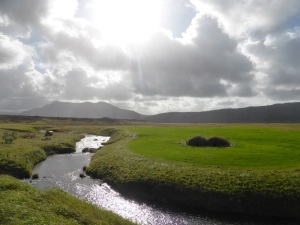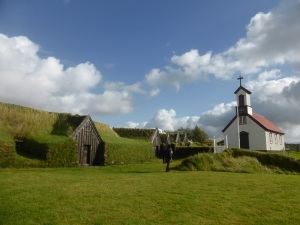Fresh off the ferry from the Vestmannaeyjar I caught a lift with a fish merchant who was happy to take an alternative route through the back roads and drop me off at Bergþórshvoll. This unprepossessing site, today just a low mound in an otherwise uninteresting field, was the home of Njal and Bergthora and the main setting of Njal’s Saga.
Njal’s Saga is the longest of all the family sagas, and some would say the best; across 159 chapters and 220 pages it tells the stories of Njal and his friends and relatives, their heroic deeds and deaths. The most tragic of all is perhaps the death of Njal’s beloved foster-son Hoskuld at the hands of Njal’s own unruly sons, for it leads directly to the climax of the saga, the burning of Bergþórshvoll.
According to the story one hundred of the enemies of the Njalssons, led by Flosi of Svinafell (see ‘Pioneers’), descended on Bergþórshvoll on a prearranged date and surrounded the house. They tried to slay Njal’s sons with force of arms, but were unable to overcome them, and resorted at last to setting fire to the house. They offered an armistice to Njal and Bergthora and the women and servants of the house, but Njal would not leave his sons to die knowing that he was too old to avenge them, and Bergthora would not leave Njal. Their young grandson too refused to leave and the three of them lay down in their bed under a thick cowskin rug while the fire raged around them. Njal’s son Skarphedin and his brothers and brother-in-law Kari ran up and down the hall, throwing out burning logs at the attackers and searching for a way out. In the end only Kari was able to escape, by running up a fallen beam and away from the house under cover of darkness.
Standing on the mound in the grey light of an overcast September morning it was hard to envisage the horror and drama of the attack on this farm a thousand years ago. But on the northern horizon something caught my eye: the jagged black ridge of the mountain Þríhyrningur. It was on Þríhyrningur that the conspirators met before the attack, and to Þríhyrningur that they returned after the Burning. According to the saga the Burners then spent three days hiding on the mountain and watching while Njal’s surviving relatives rushed around the countryside looking for them.
Even today the mountain has a slightly threatening aspect, and it must have seemed most threatening of all to Ingjald of Keldur who lived just west of Þríhyrningur. He had agreed to join the conspiracy but then changed his mind, potentially forfeiting his own life when he did not arrive at Þríhyrningur on the agreed date. After the Burning the conspirators did come for him, but as is often the way in the sagas, the wickedness of their attack on Bergþórshvoll had changed their luck, and Ingjald was able to slay Flosi’s nephew and escape.
Also visible from Bergþórshvoll was the long bank that marks the northern edge of the Austur-Landeyjar plain, where Gunnar Hamundarson lived at Hlíðarendi. Gunnar was Njal’s best friend, and it is with his adventures and feuds that the first half of the saga is primarily concerned. Gunnar is an interesting and likeable character, the greatest warrior of his day, a man who wouldn’t hesitate to attack eight men single-handedly, but also sensitive, generous, and the best of friends. After one bloody battle his pleasure in victory is tempered with confusion and sadness, and he confesses to his brother, “what I don’t know is whether I am less manly than other men because killing troubles me more than it does them.”
Unfortunately Gunnar’s prowess and noble character made him a target for the envy of lesser men, and he became embroiled in feud after feud until at last he was ordered to go into exile for three years. This he planned to do, but as he left Hlíðarendi his horse stumbled, and springing from the saddle he found himself looking back at his home. At that moment he exclaimed one of the most famous lines of all the sagas:
“Fögur er hlíðin svo að mér hefir hún aldrei jafnfögur sýnst, bleikir akrar en slegin tún, og mun eg ríða heim aftur og fara hvergi.” ‘So fair is the hillside that it has never seemed more beautiful to me, with its pale fields and mown meadows, and I will ride home again and go nowhere.’
That autumn Gunnar’s enemies attacked him in his hall at Hlíðarendi, where he defended himself with his bow and arrows for a long time. Eventually the attackers found a way to pull the roof off the hall, and then by attacking from all directions at once they were able first to cut his bow string, and then at last to kill Gunnar himself; he had killed two men, and badly wounded sixteen more.
Unlike Bergþórshvoll, Hlíðarendi still has something of the saga atmosphere about it. Not of the final battle and Gunnar’s death, but of that stirring and poignant moment when he realised he would rather die in his home than leave it. The wind rustles the long grass around a little church, for a moment the sun lights up the plain beyond and Seljalandsfoss in the distance, while a narrow belt of trees shelters the site from the active farm next door. There is a peacefulness and a quiet at Hlíðarendi, as if it still holds a respectful thousand-year silence for the hero that will forever be associated with it.









